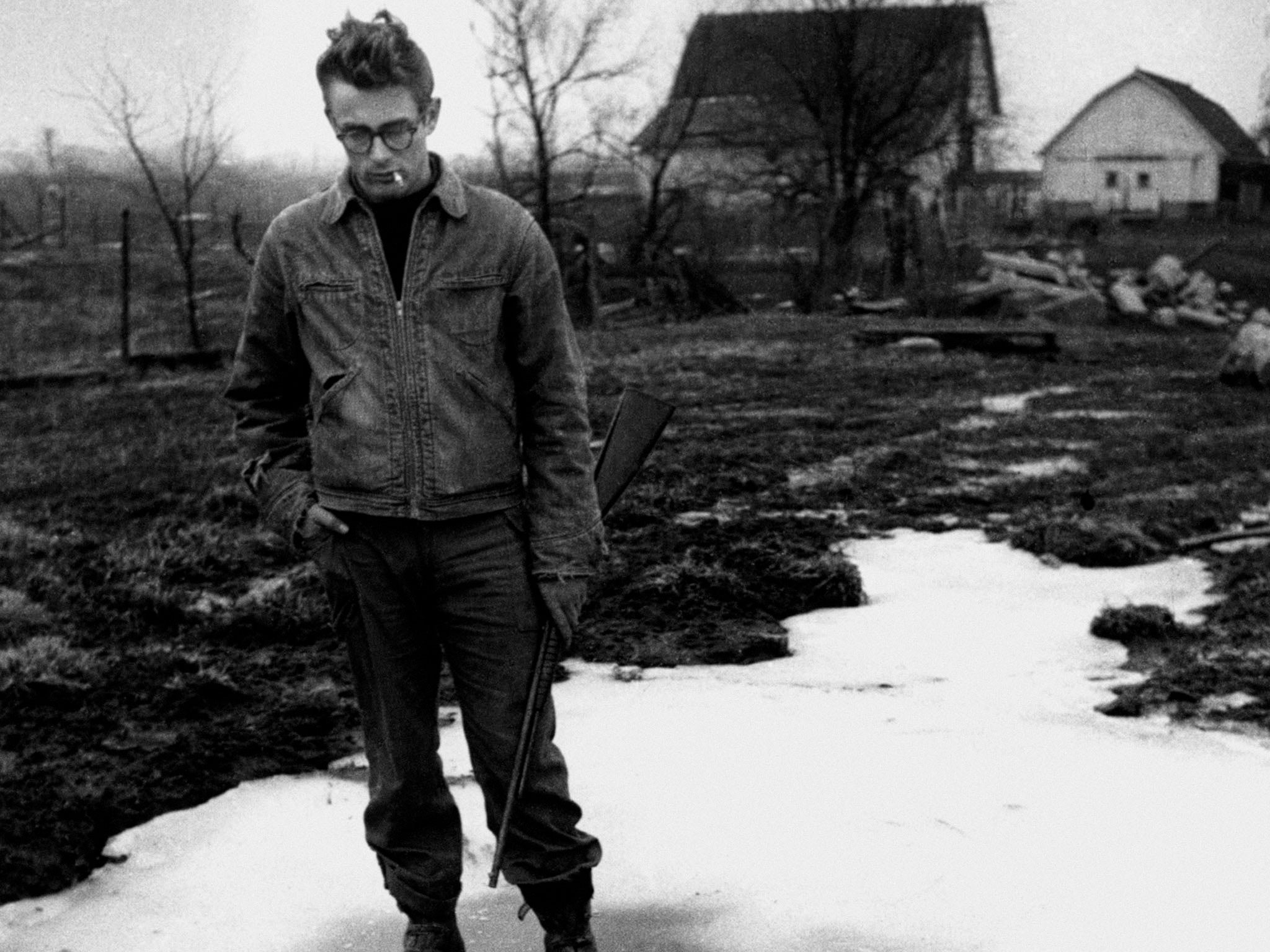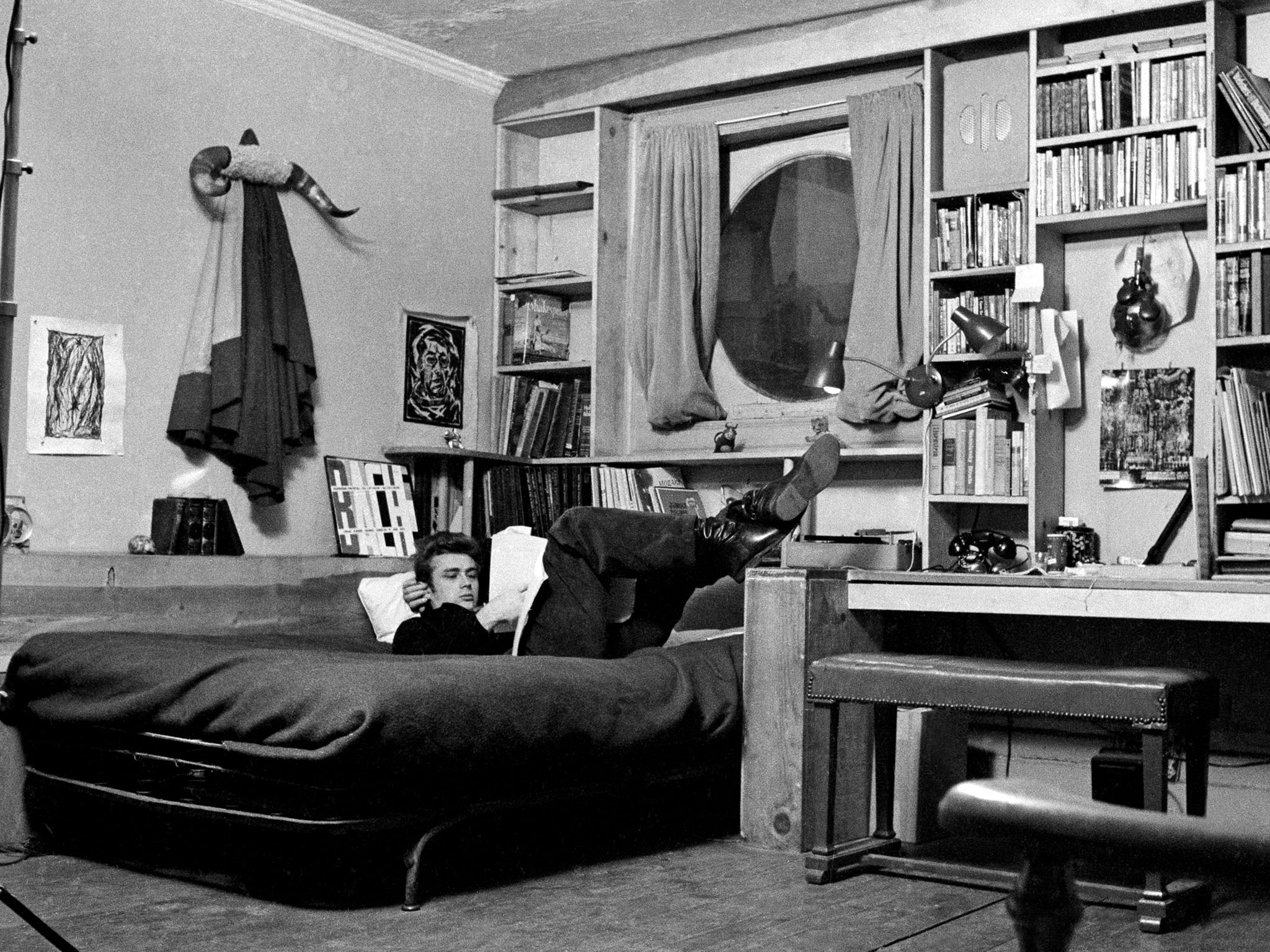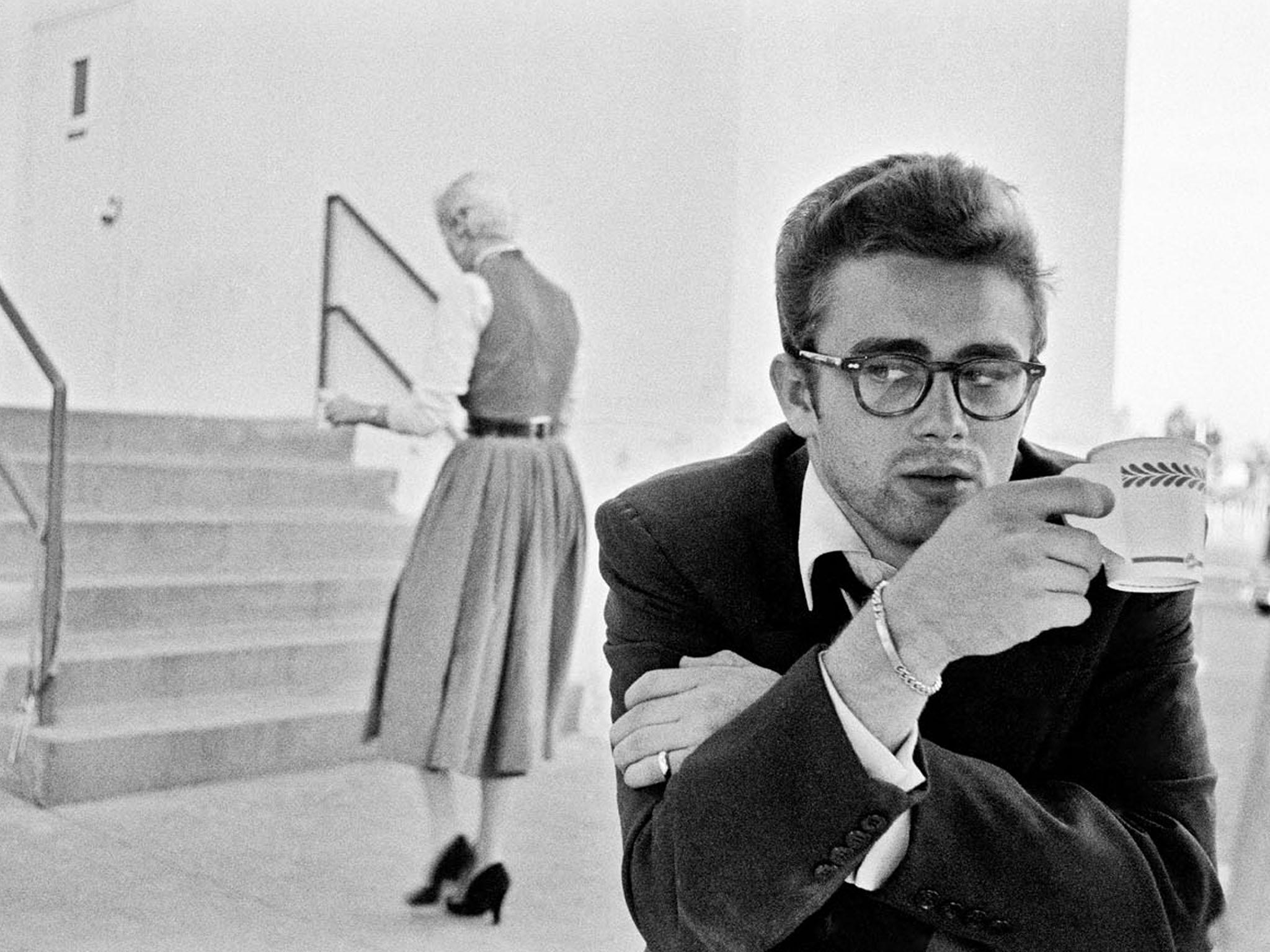James Dean: Press photographer Dennis Stock on how he came to know and love the doomed screen idol
The new film Life tells how Stock made friends with Dean while shooting a photo-essay - now, for the first time, all the pictures have been collected in a book. Joe Hyams finds out more

Your support helps us to tell the story
From reproductive rights to climate change to Big Tech, The Independent is on the ground when the story is developing. Whether it's investigating the financials of Elon Musk's pro-Trump PAC or producing our latest documentary, 'The A Word', which shines a light on the American women fighting for reproductive rights, we know how important it is to parse out the facts from the messaging.
At such a critical moment in US history, we need reporters on the ground. Your donation allows us to keep sending journalists to speak to both sides of the story.
The Independent is trusted by Americans across the entire political spectrum. And unlike many other quality news outlets, we choose not to lock Americans out of our reporting and analysis with paywalls. We believe quality journalism should be available to everyone, paid for by those who can afford it.
Your support makes all the difference.Dennis Stock became involved in a curious fashion with James Dean. They met at a Sunday afternoon soirée in director Nicholas Ray’s bungalow in the grounds of the Chateau Marmont, a Los Angeles hotel favoured by showbiz folk in the 1950s. Ray took Dennis by the arm and introduced him to a young man slouched in a chair. “Dennis,” Ray said, “I want you to meet James Dean. He’s an actor. Jimmy,” he said turning to Jimmy, “This is Dennis Stock. He’s a photographer, someone you should really get to know.” Dennis wondered what Ray saw in the moody, bespectacled young man.
Dennis and Jimmy exchanged a polite few words until they learnt they had someone in common: Gjon Mili, the eminent Life photographer who had directed Jimmy’s screen test in New York for Elia Kazan. Dennis had worked as Mili’s apprentice for four years and was also his good friend.
Jimmy mentioned that he had just finished a film with Kazan and invited Dennis to attend a sneak preview of it later in the week at a Santa Monica theatre.
Jimmy’s casual description of his work led Dennis to believe he had only a small role in East of Eden. Instead, Dennis found himself watching Jimmy’s brilliant and profound performance as the lead actor. He knew he was witnessing the birth of a star, and felt that Dean’s appeal was immediate and unconditional, representative of the new style of actors then in vogue – Marlon Brando, Paul Newman, and Montgomery Clift, who were revolutionising acting in films. After the screening Dennis passed an alley alongside the theatre and saw Jimmy wearing a leather jacket, hunched on his motorcycle. He was alone. He grinned when he saw Dennis coming toward him and asked what he thought of the film.
“You are an outstanding actor!” Dennis blurted out.
They made a date to meet the next day for breakfast at Googies, a popular Sunset Strip hangout for young stars and would-be actors. In a nostalgic mood, Jimmy talked about his childhood in Fairmount, Indiana, with such feeling that Dennis told Jimmy that he would like to do a visual biography of his youth. No photographers at that time had ever visited the childhood home of an actor, because few actors had ever been willing to expose their roots, to admit that the seeds of their talent came from quite ordinary soil.
Dennis also wanted to know where and how Jimmy had learnt his craft in New York. What Dennis was proposing was unique – a photo essay that revealed the origins of the actor.
Jimmy said he was planning to go to New York to tidy up some of the loose ends of his life. After that he planned to go to Fairmount for a few days’ rest at home with his aunt and uncle Winslow, who had raised him on their farm after the death of his mother. He invited Dennis to go with him.
Dennis occasionally worked for Life, but the editors were not enthusiastic about assigning a layout on an unknown actor. Happily, there were already positive reports in the press about Jimmy’s performance in ’Eden. Dennis would be paid $150 a day for two days’ work. He knew that the photo essay he visualised would take much more time than Life guaranteed, but he was committed to the idea.
Jimmy and Dennis flew to New York together and parted company at the midtown bus terminal, making plans to meet the following morning at Jimmy’s apartment on West 68th Street. Jimmy had dark circles under his eyes and as Dennis recalls, “He looked like hell. Jimmy was an insomniac, the worst I’d ever met, and he would simply pass out, for a few minutes or a few hours, then wake up and start out again.” The following morning, after a breakfast of coffee and toast at Cromwell’s Pharmacy in the lobby of the NBC Building at 30 Rockefeller Plaza, they went for a walk.
They visited Jimmy’s old haunts and spent time socialising in Jimmy’s apartment. The books, records, and artefacts intrigued Dennis, who felt the contents were indicative of Jimmy’s interests and inner life.
For a few days they wandered around Manhattan while Dennis photographed Jimmy interacting with people on the streets. “I wasn’t interested in a lot of the poses Jimmy took,” Dennis recalls. “They were artificial, so I let him go through a lot of nonsense until he relaxed and became spontaneous. Then I took photos that I thought were revealing of his true character. Our collaboration was the best imaginable for a portrait exploration.”
Jimmy occasionally paused during his meandering. Dennis photographed him with billboards and movie marquees, a collage of imagery that has universal meaning in the background. Times Square, with its theatre district and motion picture palaces, was the ultimate address for actors. The classic picture of Jimmy in the rain walking alone in Times Square, a perfect example of their collaboration, is considered one of the foremost iconic images of the 20th century.
Jimmy and Dennis flew from New York to Indianapolis and then went by bus to Fairmount. Within minutes of their arrival at the Winslow farm, even before Dennis had unpacked his bag in the spare room, Jimmy appeared in his doorway grinning and giggling. He had changed into his old work clothes – green shirt, green army-surplus fatigue pants and worn boots. An old camel-hair cap was tilted over his eyes at a rakish angle.
He was excited to be back where he grew up, anxious to show off the farm he called home and the town he knew like the back of his hand. Dennis realised that his initial hunch was correct. One of the major influences of Jimmy’s life was his rural upbringing. Fairmount, a classic American small town little changed over the decades, was the spine of his life story. Most of the photos Dennis would take of Jimmy were on the farm or within a one-mile radius of it.
As Jimmy showed off Fairmount to Dennis, clusters of townsfolk gathered around them, because Jimmy was a celebrity in his hometown, thanks to his appearances in many television dramas. He was at ease joking with old friends and young fans. No one seemed to be aware of Dennis discreetly taking pictures.
Dennis’s photo reportage of Jimmy in Fairmount included pictures of Jimmy playing his bongo drums in the farmyard enclosure surrounded by livestock, lying down in a trough with heifers, and posing with a huge sow.
They visited Fairmount’s Park Cemetery, where Jimmy stood alongside his great-grandfather Cal Dean’s headstone. Ironically, months later, Jimmy would be interred in the cemetery with his mother and generations of his family.
On one of those cold days, while Dennis and Jimmy were walking through Fairmount, they passed by Hunt’s Furniture Store on Main Street. “Follow me,” Jimmy said and walked into a closed and windowless back room where there were dozens of coffins. Dennis watched in horror as Jimmy took off his boots and climbed into a bronze casket. He crossed his arms and shouted, “Shoot.”
Dennis refused, saying that it was in bad taste, and suggested Jimmy get out of the casket before someone came in. Jimmy insisted. Dennis took a sequence of pictures: Jimmy lying down with his eyes closed, hands clasped over his chest, smiling and making infantile expressions.
“He was not funny,” recalls Dennis. “I had no idea he was going to do that, and I’d never have suggested he do such things. It frightened me, and I know it frightened him, too. In retrospect, I think his way of dealing with fear was to make fun of it, to taunt it.”
The last picture Dennis took was of Jimmy sitting up in the coffin, hands clasped and staring directly at the camera, a lost expression on his face.
“Everything had gone out of Jimmy by then, all the showmanship, all the cuteness. There was nothing there other than a lost person who really doesn’t quite understand why he is doing what he is doing. That’s not a moment to underestimate.”
Implicit in the series of photos was Jimmy’s dark side, coupled with his desire to be close to his mother, who had died when he was nine years old.
“We were both saddened by the end of the week in Fairmount,” Dennis recalls. “I think we both knew that Jimmy would never come back home again and that life would never be the same for him there. The trip was really a nostalgic farewell to his origins, his way of saying goodbye to the past. I don’t mean to imply that he felt he was going to die, but I believe that he felt that he was truly on the way to a far different life.”
When Dennis’s photo essay appeared in Life, in conjunction with the release of ’Eden, it confirmed Jimmy’s status as a future film star. It also earned Dennis praise.
Nicholas Ray was so impressed with Dennis’s work that he wanted to hire him as a stills photographer on Rebel Without a Cause, his film starring Jimmy, which was just going before the cameras. It was the perfect situation for Dennis and Jimmy, who had become friends.
Jimmy’s next film was Giant. Dennis went to France to photograph Spencer Tracy on location.He returned to Hollywood just as Jimmy was completing Giant. Jimmy invited him to go with him to Salinas, California, where he planned to race his new Porsche. Dennis first said “Yes,” but then something inside of him said “No.” Jimmy was killed in the Porsche the next day.
‘Dennis Stock: James Dean’, introduced by Joe Hyams (Thames & Hudson, £24.95), is published on 6 October
On the farm

‘By the time we arrived at Fairmount, Indiana, shooting on East of Eden had been completed but the film had not yet been released.
‘Still, the townspeople sensed that James Dean was somebody special. But as yet no one suspected the full proportions his fame would assume.
‘Jimmy’s parents moved to California when he was six. Three years later his mother, Mildred Dean, died of cancer. Jimmy was sent back to Indiana to be brought up by his aunt and uncle, Ortense and Marcus Winslow.
‘They were Quakers and, as Jimmy’s grandmother Emma once said of them, “Both are wise and gentle. Theirs is like a Quaker home should be. You never hear a harsh word there.”
‘February is a rough month in the Midwest – not the ideal time to observe anything, much less to probe your past. It is a lean, grey time, and that is the mood, too. But maybe this was part of Jimmy’s constantly testing everything: nothing ought to be idyllic. As was so often the case with Jimmy, he seemed to stack the cards against himself’
At home with books

‘Jimmy’s apartment on 68th Street just off Central Park West was small and stateroom-like, on the top floor – probably a maid’s room in earlier days. It was crammed with books and records. Jimmy had a need to be surrounded by books, but I’m not sure he was a real reader. As for his interest in music, he once boasted, “I collect everything from 12th and 13th-century music to the extreme moderns – you know, Schönberg, Berg, Stravinsky. I also like Sinatra’s Songs for Young Lovers album.”
‘A lot of his books had to do with the theatre, of course, but note also Kafka, Charlotte’s Web and Thomas Mann’s Death in Venice. A minister in Fairmount had turned him on to bullfighting, an interest reflected in the horns and cape on the wall. I don’t know whether Jimmy actually ever saw a bullfight, but he played a lot with that cape – fantasised, I suppose. There was something bull-like about Jimmy –testy, untamed, aggressive’
Barbershop

'For a novice actor in the 1950s, New York was the place to go. We used to roam the streets of New York together, and I liked to photograph Jimmy observing others. He was not at all fastidious about his looks; in fact, he would turn up more often than not in shaggy-dog style at meetings both formal and informal. What prompted him to walk into this barber shop near Times Square one day when we were walking, I cannot say’
Drinking in the view

‘In Hollywood, Jimmy tried to resume old routines, but a combination of his sudden fame and his own quirky, complicated personality made that difficult. Meanwhile, he was preparing to film Rebel Without a Cause [which] was the first movie of his new nine-film contract. Now poverty was a thing of the past, and with ready cash available and credit no problem, he began buying bigger and faster racing cars.
‘He was still insomniac, and night after night he would stay up driving, or drinking, with local cronies or with friends from back home who would come to visit. But no matter how late he stayed up, somehow he managed to make it to the set on time.
‘James Dean’s Hollywood career was brilliant and brief. East of Eden opened in March 1955. Rebel finished shooting in June 1955. From Rebel, Jimmy moved directly to Giant, which finished shooting in September of the same year. Before the month was out, Jimmy was dead’
Join our commenting forum
Join thought-provoking conversations, follow other Independent readers and see their replies
Comments